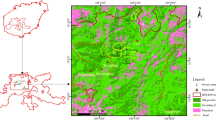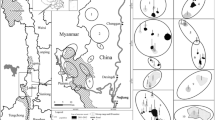Abstract
The western black crested gibbon (Nomascus concolor), or black gibbon, one of the lesser apes (Hylobatidae), is mainly distributed in Yunnan, China. Of the four recognized subspecies, N. c. jingdongensis is endemic to the Wuliang Mountain, central Yunnan, China. Of all the subspecies, this one has the largest population of any black gibbon. However, the data were all based on brief estimates. We carried out an extensive field survey on population and group distribution of the black gibbon in the Wuliang Mountains by use of loud morning songs and interviews with local people. Ninety-eight groups were confirmed and located in the mid-montane range of Wuliang Mountains. More groups are found on the east slope and the southern region than in the west and the north. Gibbons are more disjunctly distributed on the west slope, especially in the northern part. Deforestation in the late 1950s, 1960s and 1970s was the main reason for rapid loss of habitat and population decline. Hunting was another key reason for population decline and, in many cases, the main reason for local extinction.


Similar content being viewed by others
References
Bleisch W, Chen N (1990) Conservation of the black-crested gibbon in China. Oryx 24:147–156
Bleisch W, Chen N (1991) Ecology and behavior of wild black-crested gibbons (Hylobates concolor) in China with a reconsideration of evidence for polygyny. Primates 32:538–548
Bleisch W, Jiang XL (2000) Action plan for conservation of the black crested gibbons of Wuliang Mountains. Sino-Dutch Forest Conservation and Community Development Project, Yunnan Province
Brandon-Jones D, Eudey AA, Geissmann T, Groves CP, Melnick DJ, Morales JC, Shekelle M, Stewart C-B (2004) Asian Primate Classification. Int J Primatol 25:97–164
Brockelman WY, Ali R (1987) Methods of surveying and sampling forest primate populations. In: Marsh CW, Mittermeier RA (eds) Primate conservation in the tropical rain forest. Liss, New York, pp 23–62
Brockelman W, Srikosamatara S (1993) Estimation of density of gibbon groups by use of loud songs. Am J Primatol 29:93–108
Geissmann T (1997) New sounds from the crested gibbons (Hylobates concolor group): first results of a systematic revision. In: Zissler D (ed) Verhandlungen der Deutschen Zoologischen Gesellschaft: Kurzpublikatioen—Short Communications, 90. Jahresversammlung 1997 in Mainz, Gustav Fischer, Stuttgart, pp 170
Geissmann T (2002) Taxonomy and evolution of gibbons. Evol Anthropol (Suppl) 1:28–31
Geissmann T, Dang NX, Lormée N, Momberg F (2000) Vietnam primate conservation status review 2000, part 1: gibbons. Fauna and Flora International, Indochina Programme, Hanoi, 2000
Groves C (2001) Primate taxonomy. Smithsonian Institution Press, Washington
Haimoff EH, Yang XJ, He XJ, Chen N (1986) Census and survey of wild black-crested gibbons (Hylobates concolor concolor) in Yunnan Province, People’s Republic of China. Folia Primatol 46:205–214
Haimoff EH, Yang XJ, He XJ, Chen N (1987) Preliminary observations of wild black-crested gibbons (Hylobates concolor) in Yunnan Province, People’s Republic of China. Primates 28:319–335
IUCN SSC (2001) IUCN Red List Categories and Criteria, ver.3.1. IUCN-The World Conservation Union
Jiang XL, Wang YX (1997) The singing ecology and behavior of black-crested gibbons. Acta Anthropol Sin 16:293–301
Jiang XL, Wang YX (1999) Population and conservation of black-crested gibbons (Hylobates concolor jingdongensis) in Wuliang Nature Reserve, Jingdong, Yunnan. Zool Res 20:421–425
Jiang XL, Ma SL, Wang YX, Sheeran LK, Poirier FE (1994a) Group size and composition of black-crested gibbons (Hylobates concolor). Zool Res 15:15–22
Jiang XL, Ma SL, Wang YX, Sheeran LK, Poirier FE (1994b) Human encounter and predator avoidance behavior in black-crested gibbon, Hylobates concolor. Acta Anthropol Sin 13:181–188
Jiang XL, Ma SL, Wang YX, Sheeran LK, Poirier FE (1994c) The mating system of black-crested gibbon (Hylobates concolor) and its relationships with ecology, behavior and phylogeny. Acta Anthropol Sin 13:344–352
Jiang XL, Wang YX, Wang Q (1999) Coexistence of monogamy and polygyny in black-crested gibbon (Hylobates concolor). Primates 40:607–611
Lan DY (1989) Preliminary study on the group composition, behavior and ecology of black gibbons (Hylobates concolor) in southwest Yunnan. Zool Res 10(suppl):119–126
Lan DY (1993) Feeding and vocal behaviour of black gibbons (Hylobates concolor) in Yunnan: a preliminary study. Folia Primatol 60:94–105
Lan DY (1995) Distribution and conservation of black gibbons in Yunnan. In: Xia WP, Zhang YZ (eds) Primate research and conservation. China Forestry Publishing House, Beijing, pp 165–175
Lan DY, Su LD, He SJ (1990) Preliminary observations on the group composition of the wild concolor gibbons (Hylobates concolor) in Yunnan, China. Primate Rep 25:89–96
Leighton DR (1987) Gibbons: territoriality and monogamy. In: Smuts BB, Cheney DL, Seyfarth RM, Wragnham RW, Struhsaker TT (eds) Primate Societies. University of Chicago Press, Chigcago, pp 135–145
Ma SL (1993) The progress of studies on Yunnan black-crested gibbons. Chinese Primate Res Conserv News 2(2):3
Ma SL, Wang YX (1986) The taxonomy and distribution of the gibbons in southern China and its adjacent region—with description of three new subspecies. Zool Res 7:393–410
Ma SL, Wang YX, Poirier FE (1988) Taxonomy, distribution and status of gibbons (Hylobates) in southern China and adjacent areas. Primates 2:277–286
Ma SL, Wang YX, Jiang XL (1994) Status and conservation of gibbons in southwest China. In: Song DX (ed) Evaluation on animal resources from Wuling mountains area Southwestern China. Science Press, Beijing, pp 318–327
Marsh CW, Wilson WL (1981) A survey of primates in Penisular Malaysian forests. University Kebangsaan, Kuala Lumpur
Matthews A, Matthews A (2004) Survey of gorillas (Gorilla gorilla gorilla) and chimpanzees (Pan troglodytes troglodytes) in Southwestern Cameroon. Primates 45:15–24
Mills LS, Allendorf FW (1996) The one-migrant-per-generation rule in conservation management. Conserv Biol 10:1509–1518
Peng H (1998) The seed plants from Mt. Wuliang in the south-central Yunnan, China. Yunnan Science and Technology Press, Kunming
Seal U (1994) Thai gibbon life history and vortex analysis. In: Tnhkorn S, Brockelman W, Tilson R, Nimmanheminda U, Ratanakorn P, Cook R, Teare A, Castle K, Seal U (eds) Thai gibbon population and habitat viability analysis. Khao Yai, Thailand, pp 23–36
Sih A, Jonsson BG, Luikart G (2000 Habitat loss: ecological, evolutionary and genetic consequences. Trends Ecol Evol 15:132–134
Su WH, Yu CY, Qian DR, Yu QG, He SS (2004) Vegetation. In: Yu QG, Cao SS, Qian DR, Gu XS (eds) The Wuliangshan National Nature Reserve. Yunnan Science and Technology Press, Kunming, pp 115–151
Tan BJ (1985) The status of primates in China. Primate Conserv 5:63–81
Wang JL (2004) Application of the one-migrant-per-generation rule to conservation and management. Concerv Biol 18:332–343
Wang YX, Jiang XL (1995) Today and tomorrow primatological studies in China. In: Xia WP, Zhang YZ (eds) Primate research and conservation. China Forestry Publishing House, Biejing, pp 1–14
Wang YX, Jiang XL, Feng Q (2000) Distribution, status and conservation of black-crested gibbon (Hylobates concolor) in China. Acta Anthropol Sin 19:138–147
Yang DH, Zhang JY, Li C (1987) Preliminary survey on the population and distribution of gibbon in Yunnan province. Primates 28:547–549
Yunnan Forest Planning Institute (1989) Yunnan Nature Reserves. China Forestry Publishing House, Beijing
Zhang YZ, Quan GQ, Yang DH, Liu ZH, Sheeran L (1995) Population parameters of the black gibbon in China. In: Xia WP, Zhang YZ (eds) Primate research and conservation. China Forestry Publishing House, Biejing, pp 203–220
Acknowledgements
The study was supported by the Knowledge Innovation Program of the Chinese Academy of Sciences (#KSCX2-SW-119), the National Key Project for Basic Research on Ecosystem Changes in Longitudinal Range-Gorge Region and Transboundary Eco-security of Southwest China (#2003CB415103) and the Sino-Dutch Forest Conservation and Community Development Project. Many thanks to Mr. Zhang Xingwei, the director of Jingdong Nature Reserve, Mrs. Gao Suzhen, the director of Nanjian Nauture Reserve, for their kindly supports and coordination. We are debted to Mr. Li Jianqiang, Yang Wenqin, He Qifeng, Dong Wenjin, Xiong Shaorong, Luo Kaichun, Yang Kaijing and Li Kaihong for their useful field assistance. Thanks also to Mr. Song Jinxin for drawing Fig. 1. We are grateful to Dr. William Bleisch, and one anonymous reviewer for their comments on the manuscript. Special thanks to Dr. Warren Y. Brockelman for his invaluable comments and kind help, especially rewriting the part on population estimation and improving the manuscript. Part of the work was carried out at the Jointed Black Gibbon Monitoring Station of Kunming Institute of Zoology, Chinese Academy of Sciences, and Jingdong Nature Reserve.
Author information
Authors and Affiliations
Corresponding author
About this article
Cite this article
Jiang, X., Luo, Z., Zhao, S. et al. Status and distribution pattern of black crested gibbon (Nomascus concolor jingdongensis) in Wuliang Mountains, Yunnan, China: implication for conservation. Primates 47, 264–271 (2006). https://doi.org/10.1007/s10329-005-0175-3
Received:
Accepted:
Published:
Issue Date:
DOI: https://doi.org/10.1007/s10329-005-0175-3




